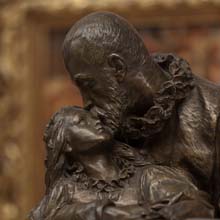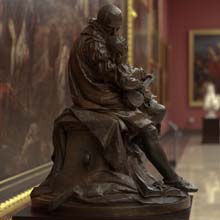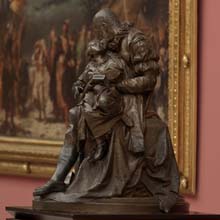



material: bronze
dimensions: 86 × 67 × 72 cm
description: The sculpture depicts Jan Kochanowski (1530–1584), a poet and playwright, contributor to the development of the Polish literary language, with his daughter Ursula playing a small lute. The child is sitting on her father’s lap, who is embracing and kissing her fondly. In this vivid scene, full of natural grace, the artist has created an allegory of paternal love, which gave rise to a masterpiece of Polish literature – "Treny", written by Kochanowski after Ursula’s death. The poet described his beloved daughter in songs full of pain and despair, praising, among other things, her poetic and musical talent. >My witty songstress, my Slavic Sappho! My estate and that which I truly know - My Lute - were to be your rightful bequest. I think of poetry itself, yet to manifest. Songs perpetually brought to life all the day By a little girl, chirping happily in her merry way. Just as the nightingale, all hid in green brake, Sings abroad on the night of her rapturous state. [Lament 6, translated by Barry Keane, source: http://www.eighthsquare.com/thren/threnodies.html Due to the naturalness of the scene, the monumentality of depiction and the veristic rendering of detail, the sculpture is close to naturalism, yet the historical subject and technical features impart an academic quality to it. Wacława Milewska
exposition: The Gallery of 19th Century Polish Art in Sukiennice,
The Cloth Hall, 1, Main Market Square
key: Around the academy >>>
dimensions: 86 × 67 × 72 cm
description: The sculpture depicts Jan Kochanowski (1530–1584), a poet and playwright, contributor to the development of the Polish literary language, with his daughter Ursula playing a small lute. The child is sitting on her father’s lap, who is embracing and kissing her fondly. In this vivid scene, full of natural grace, the artist has created an allegory of paternal love, which gave rise to a masterpiece of Polish literature – "Treny", written by Kochanowski after Ursula’s death. The poet described his beloved daughter in songs full of pain and despair, praising, among other things, her poetic and musical talent. >My witty songstress, my Slavic Sappho! My estate and that which I truly know - My Lute - were to be your rightful bequest. I think of poetry itself, yet to manifest. Songs perpetually brought to life all the day By a little girl, chirping happily in her merry way. Just as the nightingale, all hid in green brake, Sings abroad on the night of her rapturous state. [Lament 6, translated by Barry Keane, source: http://www.eighthsquare.com/thren/threnodies.html Due to the naturalness of the scene, the monumentality of depiction and the veristic rendering of detail, the sculpture is close to naturalism, yet the historical subject and technical features impart an academic quality to it. Wacława Milewska
exposition: The Gallery of 19th Century Polish Art in Sukiennice,
The Cloth Hall, 1, Main Market Square
key: Around the academy >>>












